Nestled in the heart of Tanzania, the majestic Mount Kilimanjaro beckons adventurers from around the world. Rising gracefully at an astonishing height of 5,895 meters (19,341 feet) above sea level, Mount Kilimanjaro is not just Africa's highest peak but also a representation of natural wonder and human determination. Embarking on a journey to Climb Kilimanjaro is more than just a physical feat; it's an adventure of self-discovery, offering profound insights into one's resilience, endurance, and connection with the awe-inspiring forces of nature.
Located in northern Tanzania, Kilimanjaro is a dormant stratovolcano composed of three cones: Kibo, Mawenzi, and Shira. What makes Kilimanjaro truly remarkable is its accessibility to climbers of varying skill levels. Unlike other formidable peaks that require technical climbing expertise, Kilimanjaro offers several trekking routes, each presenting its own challenges and scenic vistas.
Best Time to Climb Kilimanjaro
The best time to climb Kilimanjaro is during the dry seasons, which typically occur from late December to early March and from June to October. These periods offer the most stable weather conditions with less precipitation, making for a safer and more enjoyable climbing experience. During this time of the year, the skies are usually clear, providing excellent visibility and stunning views of the surrounding landscapes.
While climbing Kilimanjaro during the dry seasons is generally recommended, it's important to note that the mountain can be climbed year-round. However, the wet seasons, which occur from April to May and from November to early December, bring heavier rainfall and increased risk of slippery trails, mudslides, and cloudy skies, which can obscure the scenic views. Learn more about it here.
Kilimanjaro Routes and Challenges
Kilimanjaro boasts several routes, with the Marangu, Machame, Lemosho, and Rongai routes being the most popular. Each route varies in terms of duration, difficulty, and scenery, catering to different preferences and fitness levels. Regardless of the chosen route, climbers must contend with altitude sickness, extreme weather conditions, and physical exhaustion. The high altitude presents the most formidable challenge, with altitude-related illnesses such as altitude sickness and pulmonary edema posing a risk to climbers. Thus, acclimatization is crucial, with carefully planned itineraries allowing climbers to adjust gradually to the thinning air. To come up with the challenges, read our blog on a comprehensive guidebook for Kilimanjaro climbing.
Where to Go to Climb Mount Kilimanjaro
Mount Kilimanjaro is located in Tanzania, East Africa, within Kilimanjaro National Park. The starting point for most climbs is the bustling town of Moshi, which serves as a gateway for climbers. From here, you’ll embark on your journey through lush rainforests, alpine deserts, and icy summits.
Tip: Fly into Kilimanjaro International Airport (JRO) for the most convenient access.
How Long Does It Take to Climb Mount Kilimanjaro?
The time it takes to climb Kilimanjaro depends on the route you choose. Here’s a breakdown:
- Marangu Route: 5–6 days (easier but less time for acclimatization).
- Machame Route: 6–7 days (most popular for its scenic views).
- Lemosho Route: 7–8 days (ideal for acclimatization).
- Rongai Route: 6–7 days (quieter with gradual ascents).
- Northern Circuit: 8–9 days (longest but offers the best success rate).
Choosing a longer itinerary increases your chances of success and reduces the risk of altitude sickness. Most climbers take about 6–9 days to reach the summit and descend safely.
How Difficult Is It to Climb Mount Kilimanjaro?
Mount Kilimanjaro is not a technical climb—no ropes or mountaineering experience are required. However, don’t underestimate the challenge:
- Altitude is the biggest hurdle. Gradual acclimatization is key.
- Physical fitness matters. Prepare with cardio, strength, and stamina training. For training plan, Click here.
- Mental toughness will get you through tough days and chilly nights.
With proper preparation and choosing the right route, anyone with determination can conquer Kilimanjaro.
How Much Does It Cost to Climb Mount Kilimanjaro?
The cost of climbing Mount Kilimanjaro varies depending on the tour operator, route, and inclusions. On average, expect to pay between $2,000 and $5,000. Here’s what’s typically included:
- Park fees (approximately $1,000 per person).
- Guides, porters, and cooks (mandatory).
- Meals, camping equipment, and transport to the trailhead.
Tip: Avoid overly cheap tours, as they may compromise safety or fair treatment of porters.
Tips for a Successful Kilimanjaro Climb
Climbing Kilimanjaro is no joke—it’s an adventure that pushes you physically and mentally. But with the right preparation, you can make it to the summit and actually enjoy the journey. Here’s how to set yourself up for success:
1. Give Your Body Time to Adjust (Acclimatize!)
Altitude sickness is real, and it can ruin your climb if you’re not careful. The best way to avoid it? Take the longer route. More days on the mountain mean a better chance for your body to adjust to the altitude, which drastically improves your chances of reaching the summit. Slow and steady wins this race.
2. Pack Like a Pro
Your gear can make or break your experience. Dress in layers so you can adapt to changing temperatures, invest in solid hiking boots (break them in beforehand!), and bring trekking poles—they’ll save your knees on those brutal descents. Also, don’t skimp on warm gloves and a good sleeping bag; nights get freezing up there.
3. Water, Water, and More Water
Dehydration hits harder at high altitudes. You’ll need to drink at least 3–4 liters of water daily to keep your body functioning properly. It might feel excessive, but it helps with acclimatization and keeps altitude sickness at bay. Bring hydration tablets for an extra boost!
4. Train Like You Mean It
You don’t need to be an ultra-marathoner, but Kilimanjaro demands endurance. Start training at least three months in advance—focus on cardio, strength training, and long hikes with a loaded backpack. The goal is to build stamina and get your legs used to long, steep climbs.
5. Listen to Your Guides (Seriously, They Know Best)
Your guides are your lifeline on the mountain. They’ve done this climb hundreds of times and know exactly how to get you to the top safely. If they tell you to slow down, drink more water, or rest, listen. Their advice could be the difference between reaching the summit or heading back down early.
Rewards of Climbing Kilimanjaro
Despite the challenges, Kilimanjaro climbing offers unparalleled rewards. The journey is as much about self-discovery as it is about reaching the summit. As climbers ascend through diverse ecosystems, from lush rainforests to barren alpine deserts, they witness nature's sublime beauty and resilience. The bond formed among fellow climbers and the unwavering support of experienced guides further enrich the experience. Moreover, standing atop Uhuru Peak, Kilimanjaro's highest point, is a moment of triumph and reflection. The panoramic views of the surrounding plains and the ethereal sunrise illuminating the glaciers are memories that linger long after the descent.
For further information regarding Climbing Kilimanjaro in Tanzania, contact a reputable Kilimanjaro Climbing Company like Footprint Adventure for various Kilimanjaro Climbing Packages suited to different budgets and preferences. Our experienced guides ensure a safe and memorable Kilimanjaro Guided Climb experience, regardless of your Kilimanjaro Fitness Level. Explore the diverse Kilimanjaro Routes and choose the best time to climb Kilimanjaro based on your schedule and preferences. Learn about the difficulty level of climbing Kilimanjaro, and prepare yourself for the hardest part of the journey. Contact us now for an unforgettable Kilimanjaro climbing experience!

.jpg)


